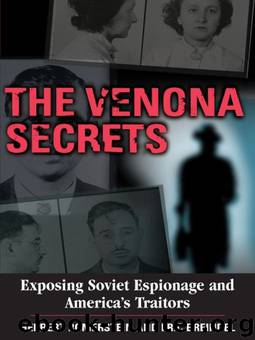The Venona Secrets: Exposing Soviet Espionage and America's Traitors (Cold War Classics) by Breindel Eric & Romerstein Herbert

Author:Breindel, Eric & Romerstein, Herbert [Breindel, Eric]
Language: eng
Format: epub
Publisher: Regnery History
Published: 2001-09-30T16:00:00+00:00
CHAPTER 8
Atomic Espionage—California Phase
EARLY IN WORLD WAR II, the NKVD learned from its agents in the American Communist Party that the Radiation Laboratory, University of California at Berkeley, was doing theoretical calculations to develop an atomic bomb. Moscow assigned the San Francisco Rezident , Gregory Kheifitz, to exploit this knowledge for espionage.
Kheifitz assigned his assistant Peter Ivanov, Soviet vice consul in San Francisco, to the project. His contact was Steve Nelson, a member of the Communist Party’s National Committee and head of the Alameda County organization of the California Communist Party. Nelson was also the head of the West Coast section of the secret underground apparatus of the Communist Party. He worked for Rudy Baker, who ran the underground from his base in New York. 1
In late March 1943 Nelson met in his Oakland, California, home with an atomic scientist, Joseph Weinberg. The FBI had a microphone in Nelson’s home and overheard the conversation. William Branigan, who later headed the FBI’s Soviet CounterIntelligence Section, was the young FBI agent who had the burdensome job of listening to the conversations in Nelson’s home. 2 Branigan heard Nelson instruct Weinberg to gather and send him information from other Party members working with him on the atom bomb project at the University of California at Berkeley. He told Weinberg that the Party members working there should destroy their membership books, refrain from using liquor, and use extreme caution in gathering and supplying atom bomb information. Weinberg, in response, reported on experiments that had been conducted to develop the atomic bomb, reading aloud a complicated formula which Nelson copied down.
A few days later, Nelson phoned Kheifitz’s subordinate Peter Ivanov and requested that they meet somewhere secretly. Ivanov suggested “the usual place.” The FBI followed Nelson and saw him meet Ivanov in the middle of an open park on the grounds of San Francisco’s St. Joseph’s Hospital. Nelson handed a package to the Soviet intelligence officer. 3
Both Weinberg and Nelson were subpoenaed by the House Committee on Un-American Activities in 1949 and questioned together. Weinberg claimed he had never met Nelson, while Nelson invoked the Fifth Amendment when asked if he knew Weinberg. 4 At a subsequent hearing of the committee, Weinberg was shown pictures of Nelson and again claimed never to have met him. When asked whether Nelson had come to his home in August 1943, he claimed not to remember such an occasion. He also denied that Communist Party functionary Bernadette Doyle was in his home at the same meeting. 5 But two special agents of the army’s CounterIntelligence Corps assigned to the atom bomb project provided the committee with sworn statements that directly contradicted Weinberg’s testimony.
James Murray, the officer in charge of the unit handling security at the atom bomb research project at the University of California, testified that a “highly confidential informant”—in reality, the FBI—had advised his office that a scientist at the radiation laboratory had disclosed secret information about the A-bomb project to a member of the Communist Party, who later passed it on to the Russian consulate in San Francisco.
Download
This site does not store any files on its server. We only index and link to content provided by other sites. Please contact the content providers to delete copyright contents if any and email us, we'll remove relevant links or contents immediately.
| Espionage | Hoaxes & Deceptions |
| Murder & Mayhem | Organized Crime |
| Serial Killers | White Collar Crime |
Mindhunter: Inside the FBI's Elite Serial Crime Unit by John E. Douglas & Mark Olshaker(9266)
Wiseguy by Nicholas Pileggi(5711)
Room 212 by Kate Stewart(5073)
Hitman by Howie Carr(5043)
Secrecy World by Jake Bernstein(4703)
Killers of the Flower Moon: The Osage Murders and the Birth of the FBI by David Grann(4410)
Papillon (English) by Henri Charrière(4229)
Breaking Free by Rachel Jeffs(4196)
Killers of the Flower Moon by David Grann(3999)
Say Nothing by Patrick Radden Keefe(3938)
American Kingpin by Nick Bilton(3822)
The Secret Barrister by The Secret Barrister(3664)
Molly's Game: From Hollywood's Elite to Wall Street's Billionaire Boys Club, My High-Stakes Adventure in the World of Underground Poker by Molly Bloom(3512)
Mysteries by Colin Wilson(3424)
In Cold Blood by Truman Capote(3348)
Signature in the Cell: DNA and the Evidence for Intelligent Design by Stephen C. Meyer(3103)
I'll Be Gone in the Dark by Michelle McNamara(3056)
Rogue Trader by Leeson Nick(3011)
Bunk by Kevin Young(2973)
